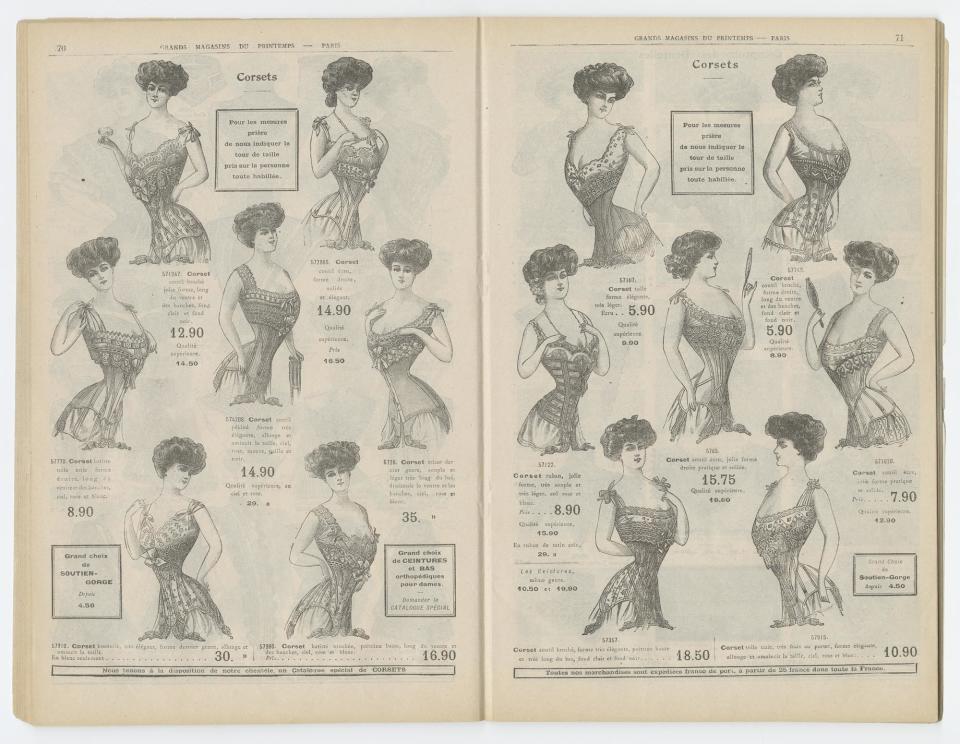‘The Birth of Department Stores’ Exhibit Dives Into Origins of Consumption, Marketing and Trends

PARIS — Modernity and marketing convened in the rise of the departments stores in Paris, brought together as the French capital transformed its architecture in the Second Empire.
As small streets gave way to grand boulevards and Haussmannian buildings, shopping became a new religion practiced in the city’s temples of consumption.
More from WWD
Walmart-Owned Myntra CEO on Tech, Storytelling and Staying Ahead of the Fashion Retail Curve
Top French Chef Hélène Darroze Believes in Cooking With Heart Over Skills
Palo Gallery Examining the Power of Portraiture in the 21st Century
A new exhibit, “The Birth of Department Stores,” at Paris’ Musée des Arts Decoratifs examines this trajectory, the democratization of fashion and modern marketing.
The exhibit brings together suits and dresses, photographs, posters, advertising calling cards, as well as archival footage of some of the very first modeling and fashion presentations; about 80 percent of the exhibit is sourced from the museum’s own collection.
Dresses, hats and lingerie are on display, along with the advertising works and catalogues. There are also children’s toys and a room full of furniture and wallpaper as department stores also gave rise to the idea of home décor as a type of style to be emulated.
“These are pieces that we had practically never shown, whether in the fashion department, in the toy department, in the advertising department with the posters themselves, but also in terms of furniture,” said MAD chief curator Amélie Gastaut.

Napoleon III was key to this transition, as he sought to modernize the city, razing Paris’ maze of alleys to create the grand boulevards we know today. He wanted to give the city a makeover in the style of London, where he had lived in exile, Gastaut said.
“Thus the department stores also became a reflection of this modernity, both in architectural terms, but also of commercial modernity, since the bosses of these department stores were setting up a new commercial system, which is the basis of the marketing we still see today.”
Colorful sketches and printed advertising posters depicting beautiful dresses were the original aspirational lifestyle — such as women strolling on the beach under parasols while still turned out in their finest — and were key to communicate this message of consumption.
“The idea of department stores is that the act of purchasing should not come from a place of necessity, but from desire,” she said. Department stores also birthed the career of window dressing, staging and styling. “The entire technique system of department stores will be based on the idea that customers are not only customers, but first and foremost visitors who will come to feel desire and creates the culture of consumption.”
The department stores took advantage of the rise of the middle class through these ads, first turning shopping into a leisure pastime on par with going to the theater, and later through the selling of vacation packages and the birth of tourism travel. Later the stores began to issue annual catalogs to advertise their wares, which soon became seasonal, grew in pages and richly illustrated goods, and classified by departments such as fashion, decoration and homemaking.
Department store-branded garments, mass produced and designed to move fast, followed trends and stores began to offer complete ready-to-wear looks.

Women also had a newfound freedom in the department stores because they offered not only shopping, but security.
“The department store was almost the only place where [women] were ‘authorized’ to go in complete safety,” Gastaut said. For the middle class, who had previously received visitors in their sitting rooms, it became a more casual, third space.
“As a place of leisure, women could spend the whole day there. It was a place where entry is free and where you can spend the whole day because it offers places to eat, you can have a drink there, you can have an exhibition there,” she said.
“It is emancipatory for the customers, and also in a certain way for the saleswomen of the department stores. The majority were from the provincial lower-middle class and coming [to Paris and] being a saleswoman at the department store was already a social climb — maybe not social ascension, but gave the possibility of independence.”
The exhibit also delves into these workers. While most departments were dominated by men, women too had employment opportunities in the department store. Employees were fed, housed and given medical care through each department store, creating a system of dependence. But it was a short shelf life for the employees: most were retired at age 35 and returned to their home cities.
Their lives were inspiration for Émile Zola’s “The Ladies Delight” — he interviewed many employees of Au Bon Marché and Grands Magasins du Louvre for the 1883 novel.

While fashion today still focuses on the idea of “French girl style,” it owes its origins to here — ads promoted the idea of “La Parisienne” and instructed women how to be elegant and have good taste through fashion.
Stores also seized on the idea of women as the primary consumers and appealed through the idealization of children — creating toy departments and focusing on how to raise children. “They were already inventing the idea that women are the best tools for selling,” added Gastaut.
“The Birth of Department Stores” runs until Oct. 13.
Best of WWD


